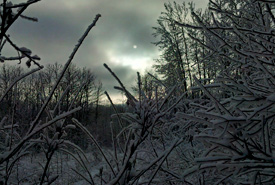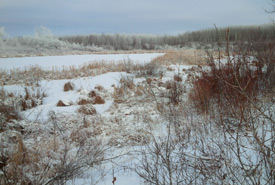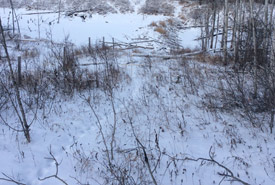Uncovering the magic of winter wildlife

Meeting Lake 03, SK (Photo by NCC)
While attending college in Winnipeg, my classmate and I used to walk north from the campus at the corner of Shaftesbury and Grant streets to explore the different sections of Assiniboine Park. As the school year was between September and April, most of our exploring was done in winter. I don’t really remember what drew us north off of the campus — the city's sights and sounds, maybe? A portion of our time was spent imagining we were Arctic explorers who, for some reason, were crossing the Bering Strait by foot — maybe to get back to our homeland, I don’t know.
Anyway, I am surprised to admit the fun I had, way back when, stomping through the drifts, leaning into the wind and knocking mini-icicles off of my wispy late-teen beard.
I was thinking of those days as I walked the fenceline of the Nature Conservancy of Canada’s (NCC’s) Meeting Lake 03 property last winter, assessing the area for future fence laying to improve the management of the area. The property is near the Touchwood Hills (or the Thickwood Hills — with all of the hills we have in Saskatchewan, who can keep these things straight?) within the West Parklands Natural Area. Acquired by NCC in 2012, it’s primarily aspen forest with a small component of white spruce, with stands of trees ranging from 20 to 40 years old.

Meeting Lake 03, SK (Photo by NCC)
The aspen stems in the thick hoar frost and the bright sun gave it a stark beauty that I was thankful to waltz through, but when I looked up I noticed my confident strides brought me to something else’s seemingly more confident and large canine-looking paw prints. The bright midday sun tried to cheer me, but my friend wasn’t there tumbling into piles of snow or tripping over curbs, so it wasn’t as carefree as when I started.
So I spent the day relaying messages of anxiety, joy and discovery — from the new-found wildlife evidence — in a series of texts and photos to my sister, sitting at her desk in Toronto. I think she appreciated it. I’m also almost certain that, like our refusal to give in to the pressure to change our clocks twice a year, as a Saskatchewan resident I’m required to stick it to Toronto in any way I can. So take that, Toronto! Take my glorious, low-resolution photos of trees and lakes and animal tracks with the occasional sun dog throw in! It’s all yours to behold and make you wonder where, along the Trans-Canada Highway, Saskatchewan is hiding all of those trees and occasional hill. (Spoiler alert: Head north! Or really, any direction off the highway. Saskatchewan has amazing natural diversity for those willing to get off the beaten trail.)
Tracking conservation through wildlife
I thought of this little scouting journey this past November as my co-worker Emily and I traversed the property, conducting an informal survey of different forest types with a local forest technician. We planned to use the information gathered — tree heights, stem density, approximate age, understorey species composition — to inform future decisions about how to best manage the property.

Animal tracks on Meeting Lake 03, SK (Photo by NCC)
Beavers rule this land, altering water flow and knocking down trees to suit their needs. Moose eat the shrubs growing in these formerly treed areas and graze the sedge meadows that the floods create.
On this particular day, the lack of leaves and snow allowed us to find a few homes of those animals that had made some of the tracks the previous winter: an old fox den my arm only fit so far into and an old, hopefully abandoned, bear den that I didn’t want to find out if I fit into.
Imprinting on the future
The landscape changes so much from one season to the next that it is difficult to imagine how best to manage the area for the longer term. We use techniques that allow us to learn from our mistakes. Now that we’ve gathered information about the property, the main tools we will use to manage it will be the introduction of processes that mimic the thinning of trees, a practice usually preformed by beavers, to introduce changes in the structure of the landscape. The strategic planting of white spruce will provide cover for small mammals.
It is possible that management decisions we make today could change the footprints that future land managers, hikers and hunters see on their own adventures.


